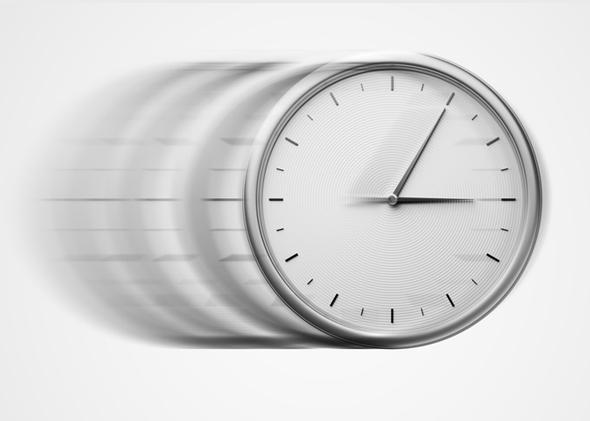For the past few weeks, headlines about this summer’s upcoming “leap second” have been everywhere. Some say that the time “may cause computer problems,” or “Could Be a Big Headache for the Internet.” And others say that the leap second will “Rattle the Internet” and “threatens to break the Internet.” Wait, what? Why does a leap second cause computer problems, and how bad is this situation really?
Digital communication systems all tell time using the atomic clock, which measures the oscillations of a cesium atom to keep extremely precise time. Historically humans have used the Earth and sun as one big clock, but the Earth’s rotation isn’t completely regular, and it’s also slowing. As a result, syncing atomic time and what’s called “universal time” is impossible, so starting in 1972 international standards bodies agreed to add leap seconds as a way of forcing the two clocks to stay in step. Since then we’ve added 25 leap seconds.
The system works fine for humans because we can just accept the extra second and essentially ignore it. But computers are programmed to have 60 seconds in a minute. Period. If you tell a computer that there’s going to unpredictably be an extra second in certain years, it will laugh at you. That is to say it will glitch because it can’t complete its normal operations.
“The leap second is a hiccup in the time scale that’s not predictable,” said John Lowe, a group leader in the National Institute of Standards and Technology’s Time and Frequency Services division. “If you’re writing code right now you know when every leap day is going to occur all the way into the future. But leap seconds can’t be predicted. There’s five or six months of advanced notice, but that can be a problem for long-term programs that are already written.”
And as Felicitas Arias, who runs the time department at the International Bureau of Weights and Measures in France, explained to Slate in 2012, there is growing consensus that leap seconds should be abolished and that atomic time doesn’t need to be synced with unversal time. “We are using a system that breaks time,” she said. “The quality of time is continuity. This is why a majority in the international community want to change the definition of [coordinated universal time] and drop the leap second.”
A similar proposal is currently awaiting a vote. But either way, it won’t stop this summer’s leap second, which was announced Jan. 5 and is scheduled for June 30.
So will the digital world implode? First, there’s an important differentiation between essential and nonessential software. Inconveniences caused by bugs in consumer products may be frustrating, and occasionally waste time or money, but they aren’t a dire threat. As Keith Winstein, a computer science researcher at Stanford University, points out, “We live in a fast-moving world where people are changing software all the time. … Maybe every 18 months Facebook has a bug and is down for a few minutes. This is the world we live in, it’s not a big problem. The leap second is one of a very large number of possible small issues.”
The assessment is different, though, for critical infrastructure. GPS, for example, already operates solely on atomic time becuase the system can’t accomodate adjustments like a leap second. As Arias pointed out, there is a 15-second time difference between GPS time and universal time. “Someone who is unaware of this could make a tragic mistake in some applications—when landing an aircraft, for instance,” she said. “And a 1-second difference in the communication between stock exchanges could provoke a gain or loss of millions of dollars.”
Demetrios Matsakis, the chief scientist for Time Services at the U.S. Naval Observatory, told Motherboard that he doesn’t know how implementing the 2015 leap second will go. “There will definitely be failures of some systems—how significant, I don’t know. … I would suggest not to be in the air flying when the leap second is enacted.”
How much damage has the leap second caused in the past? The major glitch associated with the most recent one (June 2012) is a bug in multiple versions of the open-source operating system Linux. It caused consumer services like Reddit to go down, and Australian airline Quantas had flight delays because Amadeus’ Altea booking system was affected by the glitch. Additionally, a few days before the leap second, some bad storms damaged Amazon’s cloud infrastructure, causing outages in certain products and third-party services. Though this situation was unrelated to the leap second, it took some time for services to unravel which factor was contributing to unusual network behavior.
Steve Allen, a researcher at the University of California Observatories, says that other important systems were affected by leap second-related bugs in 2012 as well, but that they weren’t publicly acknowledged. “It’s hard to talk about the things that are not documented,” he said. “I have serious concerns that there are problems much worse than anyone actually knew. … [With] operational systems that we expect to just work, when they don’t work, people aren’t going to talk about them not working, because that’s a vulnerability or a liability to shareholders or something.”
When it comes to dealing with gltches, Allen also notes that nonessential systems have the “luxury” of being able to be brought offline or rebooted to correct bugs. Many infrastructure and operational systems don’t have that type of leeway. But Allen is hopeful. “That’s the difference between this leap second and the last one. A lot of system administrators have taken a close look at this and they’re aware of it. … This time there will be even more systems that just work.”
